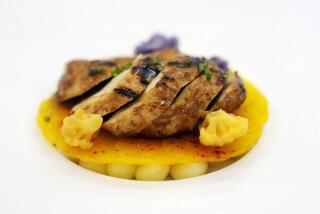Therapeutic Cloning Gets Boost in Implant Study
- Share via
Scientists have demonstrated for the first time that cloned tissues and organs can be implanted and function normally without being rejected, an achievement that brings therapeutic cloning one step closer to fruition.
Working with cloned cow cells, the scientists produced small replacement kidneys that filtered toxic materials from the bloodstream of a cow and produced urine. They also created beating heart tissue that eventually might be used to repair damaged hearts in much the same manner that patches are used to repair bicycle inner tubes.
The results, to be published in the July issue of Nature Biotechnology but available online today, provide an important “proof of principle” that cloned organs can survive and thrive in recipients, said Dr. Anthony Atala of Children’s Hospital Boston, who is one of the researchers.
Some critics of therapeutic cloning have speculated that cloned tissues would be rejected because they contain foreign DNA from a donated egg used in the cloning process. That small amount of foreign DNA could be enough to stimulate an immune response leading to rejection, critics said, but the new study shows that this does not necessarily happen.
“Before now, therapeutic cloning as a means of preventing rejection was criticized by some as being purely theoretical--just an idea,” said Dr. Robert Lanza of Advanced Cell Technology Inc., another of the paper’s authors.
“This study furnishes the first scientific evidence that cloned tissues can be transplanted back into animals without being destroyed by the body’s immune system,” he said.
As many as 3,000 Americans die every day from diseases that could possibly be treated by therapeutic cloning, according to the U.S. Centers for Disease Control and Prevention. Much larger numbers could have a greatly improved quality of life if they received replacement tissues and organs produced by the technique.
By 2010, for example, it is estimated that at least 2 million Americans will suffer from end-stage kidney disease that could be treated with artificial kidneys produced by therapeutic cloning. The new results suggest those kidneys are on the horizon.
Therapeutic cloning involves taking DNA from the nucleus of skin or other cells from the prospective recipient and implanting it in a donated egg cell from which the DNA has been removed. That cell then becomes the equivalent of a fertilized egg and can grow into embryonic tissue.
Theoretically, the embryo could be implanted into a surrogate mother and grown into a fetus. But in therapeutic cloning, the small mass of cells is used as a source of stem cells, which have the ability to grow into a variety of adult tissues.
The new findings come as the Senate is gearing up for a vote about whether to ban human cloning in the United States.
The House has passed a bill banning all forms of human cloning, and President Bush has supported it strongly. The Senate is considering two competing bills, one that would ban all forms of human cloning and one that would ban human cloning for reproductive purposes but not research purposes such as therapeutic cloning.
The Senate appears to be evenly split between the two bills. Proponents of therapeutic cloning hope that the new results might sway more senators toward their position.
In the new research, a team from Advanced Cell Technology and Children’s Hospital Boston obtained cow eggs (oocytes) and removed and discarded the eggs’ DNA.
In its place, they implanted nuclear DNA from skin cells taken from the ears of adult cows. The cells were then induced to become embryonic cell masses that were transferred into surrogate mother cows for a five- to six-week incubation period.
This step was necessary because researchers do not yet know how to induce bovine embryonic stem cells to become specific organs. Scientists know how to do this with human cells, however, and the cell masses used for human therapeutic cloning would not have to be implanted into surrogate mothers.
Six weeks after implantation, heart, skeletal muscle and kidney cells from the cow embryos were collected and grown in the laboratory. These were then seeded onto three-dimensional scaffolds in the shape of kidneys and other organs. These structures were then implanted into the cows from which the DNA was obtained.
The results were “pretty spectacular,” Lanza said. Not only were the tissues not rejected, but they spontaneously grew into functioning organs.
The kidney cells, for example, grew into a small kidney that became connected to the body’s blood system. These kidneys removed toxic materials from the blood stream with about 60% of a natural kidney’s efficiency and dumped them into a straw-colored urine, Lanza said.
The kidneys also produced critical hormones and vitamins that are normally produced by the natural organs.
The next step, said Atala, is to grow larger organs that might be used to replace the natural kidneys. “This was just a first step, and there is still a lot of work that needs to be done,” he said. “It’s hard to predict a time scale now.”






